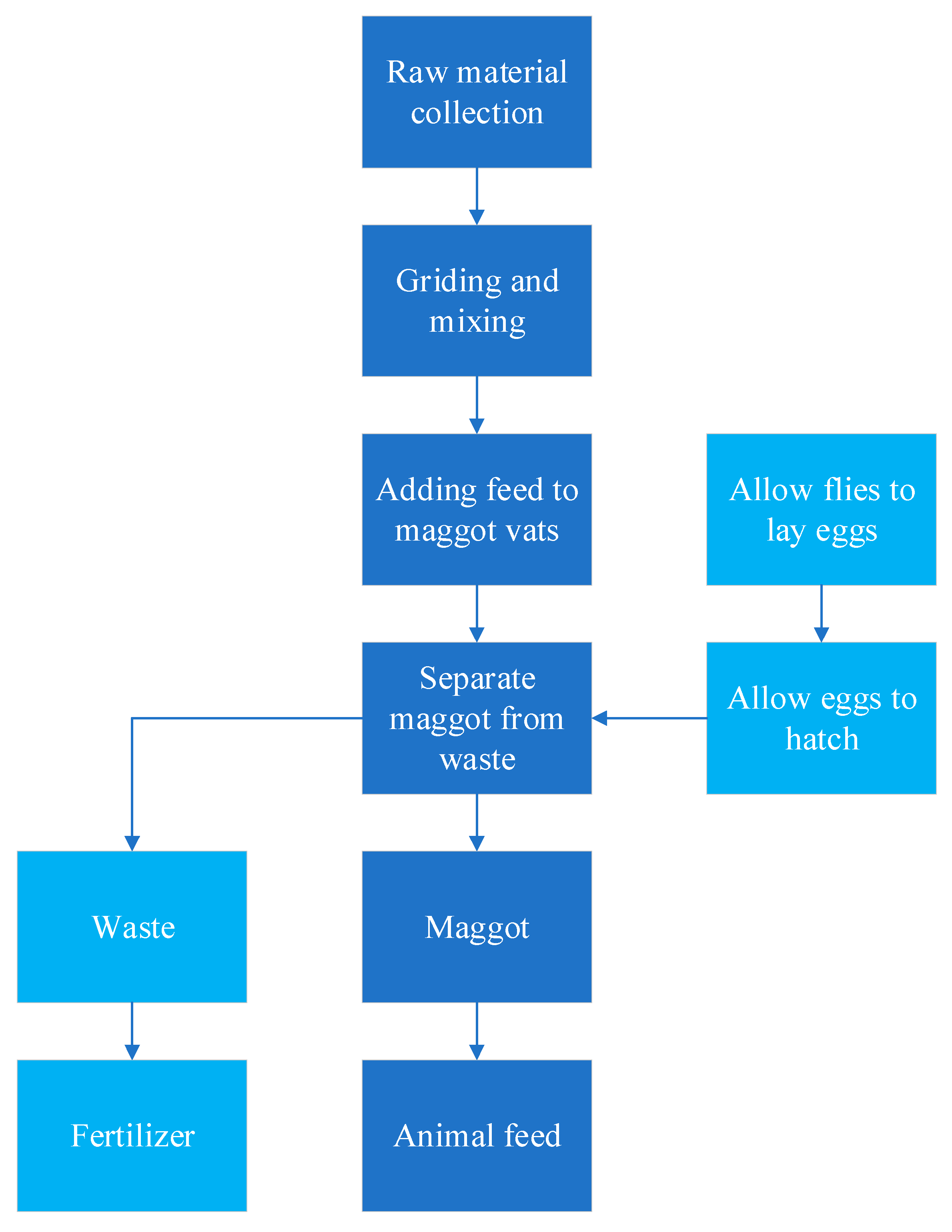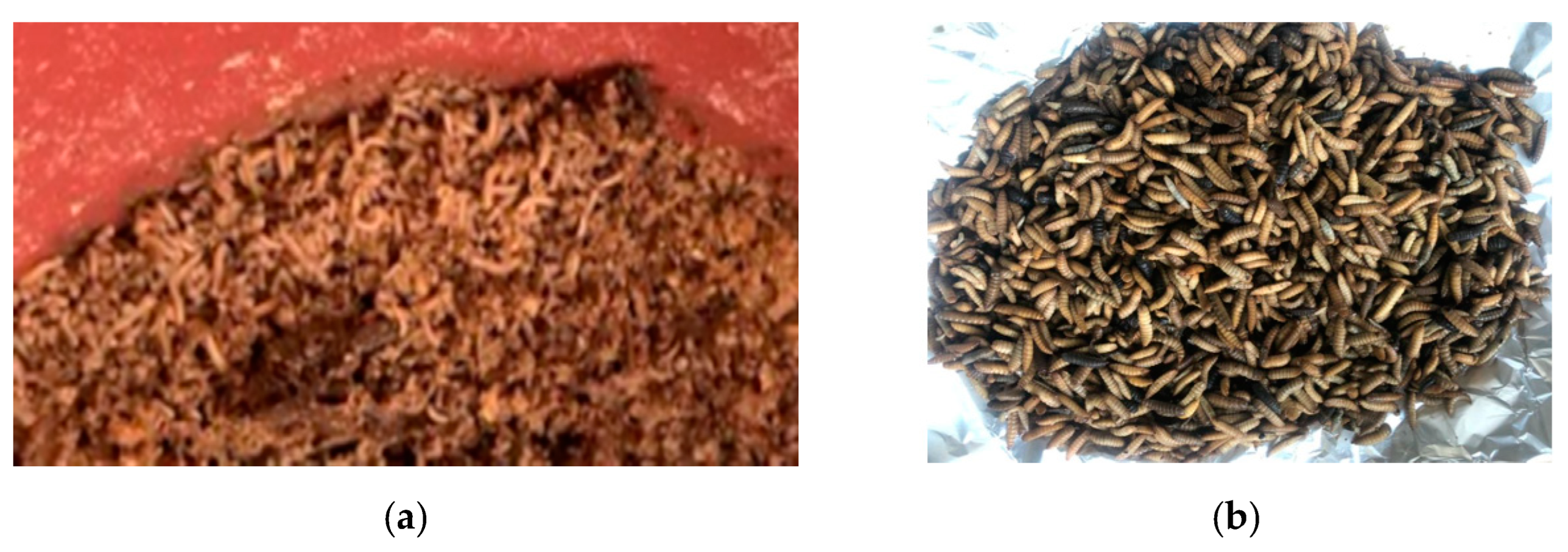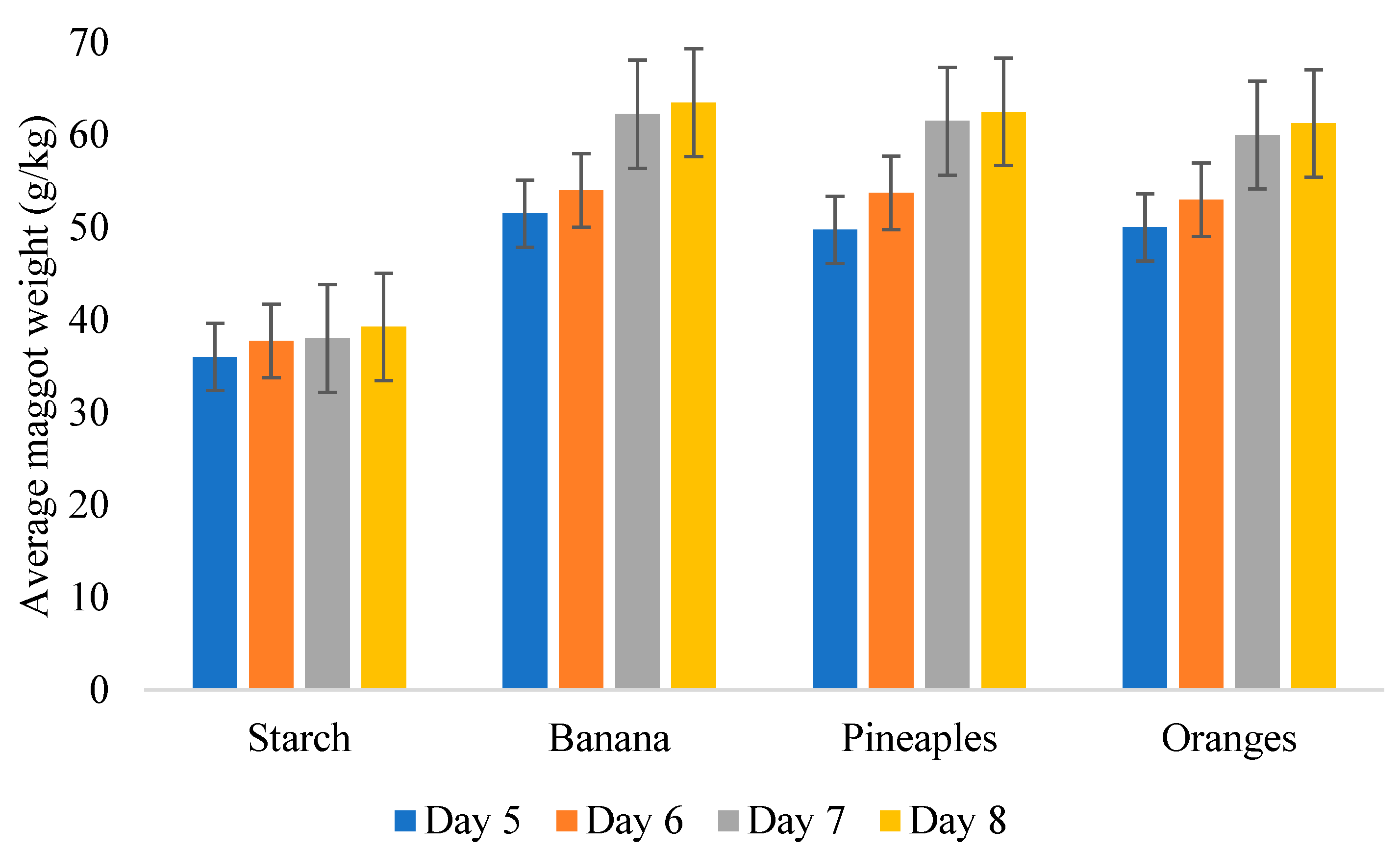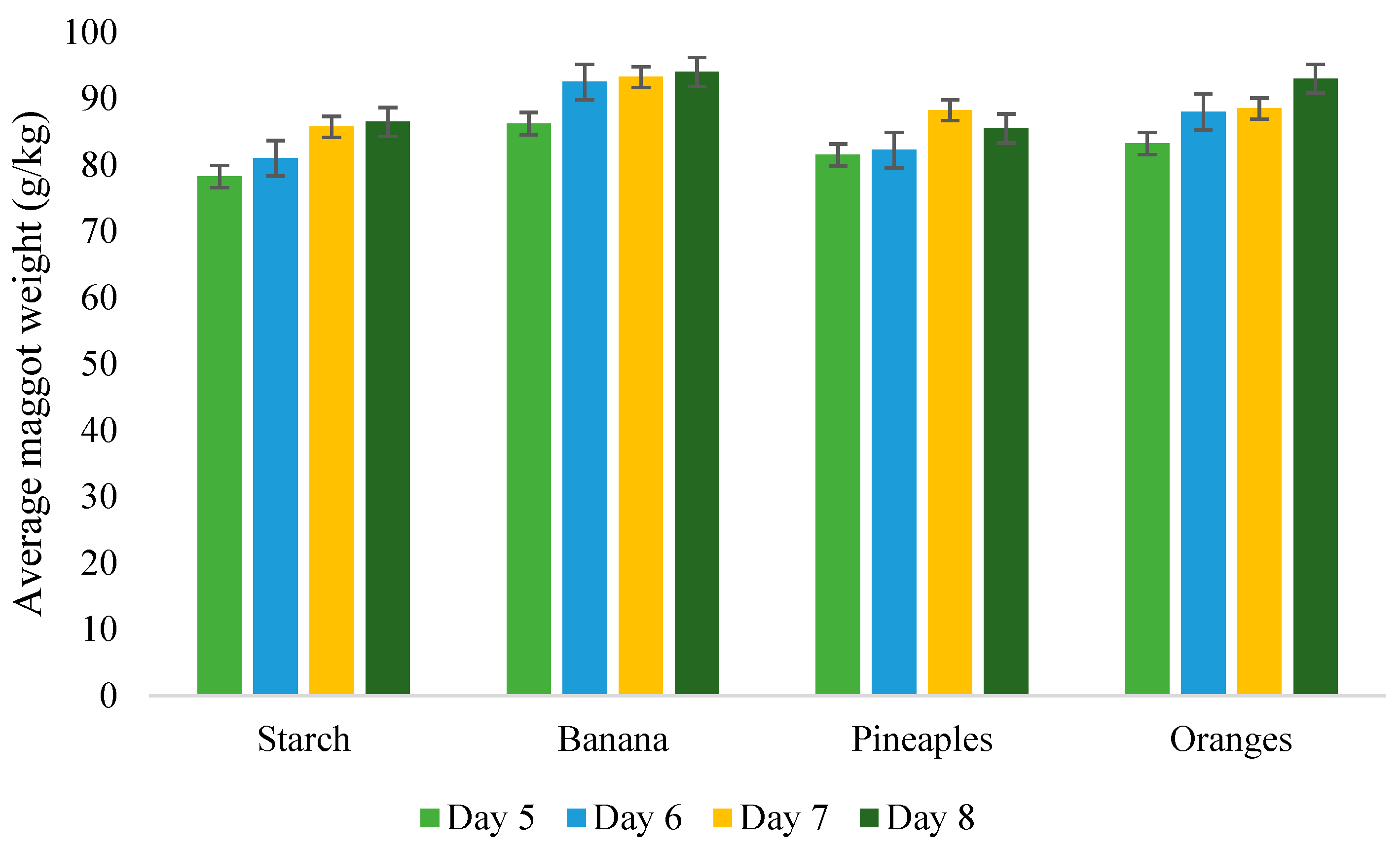1. Introduction
Due to global population growth, the demand for food has also been increasing. However, the growth in food demand has been accompanied by a high production of waste [
1,
2,
3]. In fact, a significant amount of food waste is generated every day worldwide [
4].
Unfortunately, the capacity to handle such a massive waste is also severely limited by financial resources [
5,
6]. There is a range of strategies for dealing with food waste that is currently in use, including landfilling [
7], composting [
8], food waste disposer [
9,
10], and direct anaerobic digestion [
11]. However, each food waste management approach is linked to a number of drawbacks. For instance, landfills have been widely used for the disposal of food waste [
12,
13,
14]. However, the challenge is that food waste in landfills rots and produces a large amount of methane, a highly powerful greenhouse gas [
15]. Excessive levels of greenhouse gases like methane, carbon dioxide, and chlorofluorocarbons heat the earth’s atmosphere by absorbing infrared radiation, which contributes to global warming and other types of climate change [
16,
17,
18].
As a result, for the protection of human health and the environment in general it is critical to explore and develop readily available, cost-effective, and environmentally friendly technologies for the recovery of food waste. As one of the most valuable and limited resources, proper food waste management can also assist to safeguard water resources from pollution. Maggot production as animal feed stands to be among the relatively cost-effective approaches for food waste recovery [
19,
20,
21]. Maggots can be defined as fly larvae, typically of the common housefly as well as the bluebottle species [
22]. The production mechanism is that flies are attracted to food and other sorts of rubbish, they then lay their eggs on the rubbish, the latter eventually hatching into maggots [
23]. Regrettably, the information on how maggot production can be a useful tool for food waste management is still scarce.
The flies can effectively convert organic waste into a protein-rich end product that is an excellent source for animal feed [
24]. The most prevalent application is as a source of protein for chickens. The larvae can also be processed to separate the protein, which can subsequently be used in animal, poultry, and fish feed. The maggot feces can be used as landscaping compost. In that matter, the leftover product remaining from the decomposition process can be a high nitrogen organic fertilizer. For example, it is estimated that to produce 1 kg of farmed fish in any aquaculture system, 1–8 kilos of feed are required [
25]. In the field of fish farming, the fish feed is made up of raw materials, such as straw meal [
26], soybean cake [
27], peanut cake [
28], corn protein powder, rice bran [
29], and wheat bran [
30], which in turn has been increasing raw material competition. Moreover, raising chickens on poultry farms is equally challenging at the moment due to the high feed demand [
31]. It is estimated that chickens require double the amount of grain in comparison to the meat they produce [
32]. In general, the demand for feed has made nearly 40% of all grain produced in the world end up as animal feed [
33].
Many factors can affect the productivity of maggots [
34,
35] including factors related to the substrate’s initial conditions and the type of material used for the production. Unfortunately, there are insufficient studies to provide enough information on how these factors would affect the productivity of maggots on different food waste materials. Additionally, the information on the potential of maggot production for waste recovery and reduction based on different substrate materials is still scarce. Unlike fruit flies, which like sweet foods and are more frequently attracted to overripe fruit, spilled soda, and alcohol, ordinary house flies are drawn to decaying organic waste, such as feces and rotting flesh. Therefore, using a fly attractant has the potential to increase the number of flies attracted to the substrates and increase system productivity.
This study investigates the potential of recovering food waste through maggots’ production. Different factors, such as time and application of fly attractants to maggot production, are also investigated. The experiment uses four different types of food waste (starchy food leftovers, rotten bananas and peels, pineapple peels, and rotten oranges). The breeding vats are divided into 5-day harvesting, 6-day harvesting, 7-day harvesting, and 8-day harvesting. In addition, the amount of waste reduced by maggots from the investigated substrate materials is computed to investigate the potential of maggot production for organic waste reduction. Furthermore, box and whisker plots are developed to evaluate the data distributions among the selected maggot production parameters.
2. Materials and Methods
2.1. Material Collection, Processing, and Experimental Setup
The substrate materials were grouped into four categories; starchy food leftovers (such as potatoes, bread, rice, pasta, and cereals), rotten bananas and peels, rotten pineapples and peels, and rotten oranges. The materials were collected from different parts of Dar es Salaam, including restaurants and markets. Dar es Salaam is a city (and a former capital city) in Tanzania, remaining the largest city in the country by population.
The materials were grouped accordingly and ground into smaller particles using a grinding machine. In addition, the materials were properly mixed before introducing them into the breeding vats. A general flowchart provides a summary of this process in
Figure 1. To get rid of any potential fly eggs or larvae that might have been present in the substrate when collecting the materials, all of the substrates utilized in this study were placed in an airtight container for more than 12 h before the studies began.
For all of the experiments, a substrate of 2 kg was used. For the substrates containing fly attractants, approximately 10% of the substrate weight of fly attractants composed of thoroughly mixed cattle blood and decomposing meat waste were thoroughly mixed and placed randomly in the breeding vats. The selection of the fly attractant is based on the fact that decomposing organic filth, such as rotting meat, has a tendency of attracting common house flies. The breeding vats were then exposed for approximately 8 h to attract houseflies as a process of naturally laying their eggs. After exposing the breeding vats, the substrates were covered using perforated polythene cover to provide shading. To make sure that moisture is maintained in breeding vats, water had to be sprinkled at least once per day.
In general, the study had two main cases: case number one was based on the group of substrates that was cultured without adding fly attractant, while case number two was based on the group of substrates mixed with fly attractant. Both cases were investigated under 5-day harvesting, 6-day harvesting, 7-day harvesting, and 8-day harvesting. Fresh organic substrates were collected across the city, including starchy food leftovers (such as rice and bread), rotten bananas and peels, rotten pineapples and peels, and rotten oranges.
In general, a regular sprinkle of water (at least twice a day) was used to keep the substrates moist. Maggots were manually collected (completely separated from the residue), cleaned, blanched with hot water, and then weighed to determine the total maggot weight from each substrate.
2.2. Material Characteristics
Moisture (water) content, pH, chemical oxygen demand (COD), temperature, and organic matter content were among the parameters investigated in the prepared materials before breeding. The analyzed waste materials’ concentrations of the aforementioned parameters varied slightly from one sample to the other. In general, from all the investigated materials, pH ranged from 4.2 to 9.5, with the lowest pH observed from the orange and pineapple materials. The acidic nature of the pineapple can be linked to the presence of bromelain (a corrosive chemical that breaks down amino acids. Whereas, on the other hand, the acidic nature of the orange materials can be linked to the fact that oranges are characterized by the possession of a high vitamin C (ascorbic acid) concentration, making them relatively acidic.
To be more specific, the moisture content in the starch materials ranged from 64.6% to 88.5%, while pH ranged from 6 to 9.5, COD ranged from 4865 mg/L to 9451 mg/L, temperature ranged from 19.4 °C to 30 °C, and organic matter was observed to range from 68.8% to 90%.
Additionally, the moisture content in the banana materials ranged from 79.9% to 91.1%, pH ranged from 7.2 to 9.9, COD ranged from 5209 mg/L to 10248 mg/L, temperature ranged from 20.2 °C to 28.5 °C, and organic matter was observed to range from 89.9% to 95.6%.
On the other hand, the moisture content in the pineapple materials ranged from 80.4% to 92%, pH ranged from 4.4 to 5.8, COD ranged from 6544 mg/L to 9552 mg/L, temperature ranged from 21.6 °C to 29.9 °C, and organic matter was observed to range from 92.3% to 95.2%.
The moisture content in the orange materials ranged from 84% to 90%, pH ranged from 4.2 to 6.8, COD ranged from 4469 mg/L to 11,425 mg/L, temperature ranged from 20 °C to 30.5 °C, and the organic matter content was observed to range from 90.4% to 95.9%.
As previously highlighted, the breeding vats were divided into: 5-day harvesting, 6-day harvesting, 7-day harvesting, and 8-day harvesting, whereby the pH in the substrates was measured using conical-tip electrodes (Mettler Toledo, Columbus, OH, USA). The COD in the samples was measured using the Optimized APHA Standard Method 5220 D-Closed Reflux Colorimetric for COD determination of solid samples [
36]. The Walkley and Black method was used to measure the organic matter in the samples [
37], while moisture content determination was based on the simple arithmetic of subtracting the weight of the dry sample from the total weight of the wet sample divided by the total weight of the wet sample multiplied by 100.
Figure 2 presents the summary of the material preparation processes.
2.3. Statistical Methods
2.3.1. Correlation Analysis
To investigate the relationship among the studied parameters, correlation matrices were developed. These matrices were important to evaluate the strength of the relationship among the potential selected parameters affecting maggot production. According to the matrices, a high correlation meant that there was a significant association between two or more variables. While a low correlation indicated that the variables had little in common. The interpretation of the correlation indices employed in this investigation is summarized in
Table 1.
2.3.2. Analysis of Variance (ANOVA)
A single-factor Analysis of Variance (ANOVA) was used to test if the differences between sets of data were statistically significant. This approach takes samples from each group and assesses the levels of variance within them. To be more precise, the p-value and alpha (0.05) were combined to calculate the significance threshold. It should be emphasized that the probability to reject the null hypothesis (even if it is true) is represented by the alpha value. The null hypothesis is accepted if the p-value is larger than the alpha value. On the other hand, the p-value reflects the possibility of obtaining a result that is more extreme than that received from the experiment.
In addition, the T-test (Two-Sample Assuming Equal Variances) was employed to see if there was a significant difference in the means of two groups of each parameter as determined by the two treatment procedures. The degree of the difference in terms of data variation is expressed by the T-value. As a result, the greater the value of T, the stronger the evidence that the null hypothesis is untrue.
Tukey’s HSD (honestly significant difference) test was also used in the study, which is a single-step multiple comparison process. It was applied to identify means that differed significantly from one another.
4. Conclusions
The potential of recovering food waste through maggot production has been investigated, including the impact of fly attractant on the general performance of maggot production. From the results, it was observed that the application of fly attractant to the substrates had a significant influence on improving maggot weight. For instance, the mean maggot weight from the starch materials increased to approximately 119.54% with the application of fly attractant compared to the mean value obtained from the maggot weight without applying the fly attractant. Based on the correlation analysis, the number of days before harvesting and the average maggot weight had a very high correlation, with a correlation score of 0.96 (without fly attractant) and 0.87 (with fly attractant). However, as previously highlighted, the unpredictable changes in pH led to a moderate correlation between the pH and the average maggot weight, with a correlation index of 0.66 (without fly attractant) and 0.48 (with fly attractant). Furthermore, it was shown that applying a fly attractant significantly improved maggot yield. On the eighth day, for example, the banana materials produced up to 94 g/kg of maggot weight, a 32.4% increase over the identical material without a fly attractant. The relative dry weight loss in the trials, on the other hand, ranged from 52.5% to 82.4%. That is to say, in 1 kg of food waste material, approximately 0.525 kg to 0.824 kg was consumed during the maggot production process. The results of this study also showed that maggot production (especially when combined with the use of a fly attractant) can be an effective way to recover food waste. The leftovers from the maggot generation process, on the other hand, can be used as an organic fertilizer. Future research in this area could look into the possibility of maggot production waste as an organic manure for plant growth.












